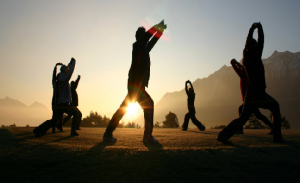 This month our Moving into Meditation class is studying the Yoga Ethic of Aparigraha. Here are some of the resources we used in this morning’s practice of guided relaxation, mindful movement and sitting meditation.
This month our Moving into Meditation class is studying the Yoga Ethic of Aparigraha. Here are some of the resources we used in this morning’s practice of guided relaxation, mindful movement and sitting meditation.
We used the Pavamana Asatoma Mantra and Bhramari to seed our breathing consciousness in our pranayama practice.
We drew inspiration from the poet and philosopher David Whyte’s explorations on forgiveness taken from Consolations: The Solace, Nourishment and Underlying Meaning of Everyday Words.
Guided Relaxation
Welcome . . . to this present moment . . . as you feel your breathing . . . you become more aware of . . how your body is a field of sensations expressing themselves in unique and ever changing ways . . . We can feel areas of heaviness . . . . and light . . . warmth . . . cold . . . vibration . . . stillness . . . fluidity . . . solidity . . . pulsation . . . tension and spaciousness . . . . those physical expressions tinged with emotion . . . memory . . . thought . . . We can feel the many feelings un-captured by language yet accessible in the time and space of our awareness . . . In the time and space we offer ourselves we begin to sense the issues in our very tissues . . .
 Yoga philosophy describes these issues we come to embody as “Samskaras” the impressions of our past actions. . . . When we perform an action, a subtle impression is deposited in our mind-field. Each time the action is repeated or a story is told, the impression becomes stronger and we form a habit or a belief. Our strong habit patterns continue to motivate our thoughts, speech, and actions. They can alter our body chemistry, our feeling and our thinking . . . . These powerful impressions can become the determining factors of our personality, and the way we perceive others . . . the way we perceive the world. (From Yoga International article What Are Samskaras and How do They Affect Us?)
Yoga philosophy describes these issues we come to embody as “Samskaras” the impressions of our past actions. . . . When we perform an action, a subtle impression is deposited in our mind-field. Each time the action is repeated or a story is told, the impression becomes stronger and we form a habit or a belief. Our strong habit patterns continue to motivate our thoughts, speech, and actions. They can alter our body chemistry, our feeling and our thinking . . . . These powerful impressions can become the determining factors of our personality, and the way we perceive others . . . the way we perceive the world. (From Yoga International article What Are Samskaras and How do They Affect Us?)
In a physical sense these Samskaras become like scars. We all have areas we can’t seem to heal, hurtful parts of ourselves born of memories we can’t let go of. These scars deepen as we repeat painful habits . . .We get stuck replaying painful stories over and over again in our heads. We need impetus—a fire, an inspiration—to get unstuck.
 Yoga practices create the heat of transformation – the form of Tapas that is generated through intense commitment . . . in the forms of daily yoga asana, pranayama, and meditation. These forms can help burn up our Samskaras and replace them with positive impressions that support us being kinder, gentler, more open people.
Yoga practices create the heat of transformation – the form of Tapas that is generated through intense commitment . . . in the forms of daily yoga asana, pranayama, and meditation. These forms can help burn up our Samskaras and replace them with positive impressions that support us being kinder, gentler, more open people.
One commentary of the Yoga Sutra defines Tapas as “deliberately acting in a way that causes positive change in ourselves – through conscious and compassionate actions. The heat generated in practicing day after day with the intention of opening our heart will “incinerate physical, mental, and emotional impurities and refine the body, sensory organs, and heart-mind.”
This healing change is at the heart of forgiveness . . . . in forgiveness, we free ourselves from the painful beliefs and behaviors that keep our resentments alive. We can work with three forms of forgiveness: forgiveness from others, forgiveness for ourselves, and forgiveness for those who have hurt or harmed us. Healing change becomes a process of letting go . . . . letting go again and again . . . which is the heart of Aparigraha.
As we continue coming together in practice . . . we begin to open to an experience of healing change . . . we begin by easing our grip on those beliefs that deepen our scars . . . . the imprints of experience on our cells and tissues . . . the postural molds and bracing patterns . . . the habitual ways we meet the world . . . There is so much we hold . . . and so much we might forgive . . .
Poet and philosopher David Whyte describes:
 “forgiveness is a heartache and difficult to achieve because strangely, it not only refuses to eliminate the original wound, but actually draws us closer to its source. To approach forgiveness is to close in on the nature of the hurt itself, the only remedy being, as we approach its raw center, to reimagine our relation to it.”
“forgiveness is a heartache and difficult to achieve because strangely, it not only refuses to eliminate the original wound, but actually draws us closer to its source. To approach forgiveness is to close in on the nature of the hurt itself, the only remedy being, as we approach its raw center, to reimagine our relation to it.”
Whyte asserts that “all friendships of any length are based on a continued, mutual forgiveness. . . . ” He explores the true source of forgiveness:
“Strangely, forgiveness never arises from the part of us that was actually wounded. The wounded self may be the part of us incapable of forgetting, and perhaps, not actually meant to forget . . .
Stranger still, it is that wounded, branded, un-forgetting part of us that eventually makes forgiveness an act of compassion rather than one of simple forgetting. To forgive is to assume a larger identity than the person who was first hurt, to mature and bring to fruition an identity that can put its arm, not only around the afflicted one within but also around the memories seared within us by the original blow. . . [We] extend our understanding to [the] one who first delivered . . . [the blow].
Forgiveness is a skill, a way of preserving clarity, sanity and generosity . . . a beautiful way of shaping the mind to a future we want for ourselves . . .
To forgive is to put oneself in a larger gravitational field of experience than the one that first seemed to hurt us. We reimagine ourselves in the light of our maturity and we reimagine the past in the light of our new identity, we allow ourselves to be gifted by a story larger than the story that first hurt us and left us bereft.”
In Yoga we practice Aparigraha: We let go and open to change . . . to healing.
Right now we can travel our awareness through our bodies, hearts and minds sensing into those areas that might be bearing the scars of old wounds and how these scars affect who we feel and think and ultimately breathe and move. . . . . We can notice how we’re breathing now and how our breathing changes . . . notice how our bodies feel when we sense our wounds . . .
 We can use breath, movement and touch to yield to change . . . perhaps into a more expansive identity . . We can explore “Forgiveness as a skill, a way of preserving clarity, sanity and generosity . . . a beautiful way of shaping the mind to a future we want for ourselves . . .”
We can use breath, movement and touch to yield to change . . . perhaps into a more expansive identity . . We can explore “Forgiveness as a skill, a way of preserving clarity, sanity and generosity . . . a beautiful way of shaping the mind to a future we want for ourselves . . .”
We can trust the breath to guide us into that “ . . . larger gravitational field of experience . . .” where we can reimagine ourselves in loving kindness and compassion. . . . “we allow ourselves to be gifted by a story larger than the story that first hurt us and left us bereft.”
